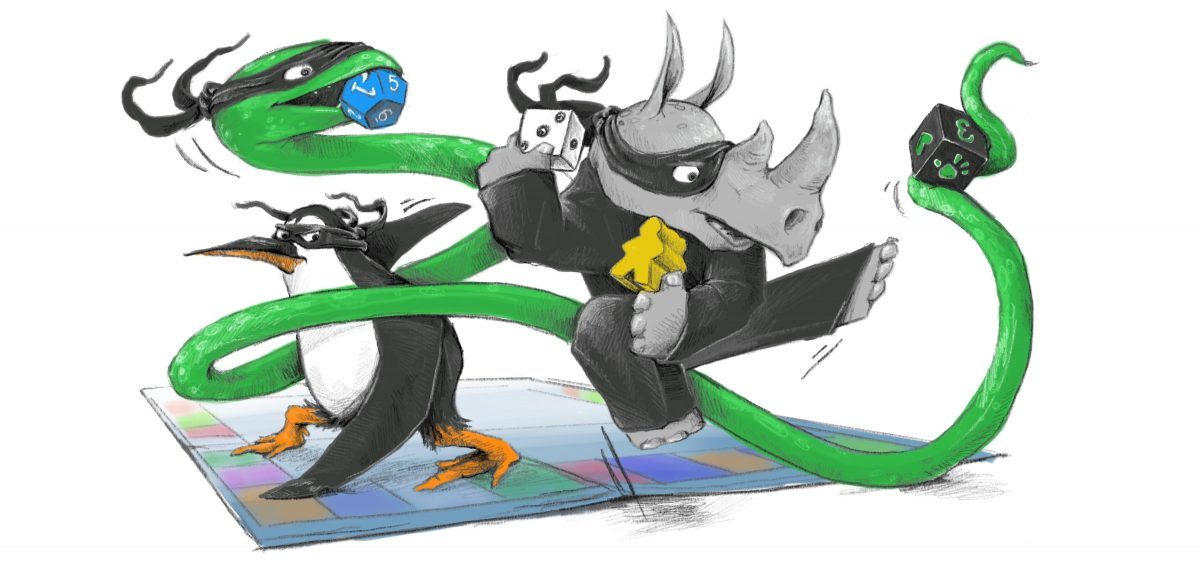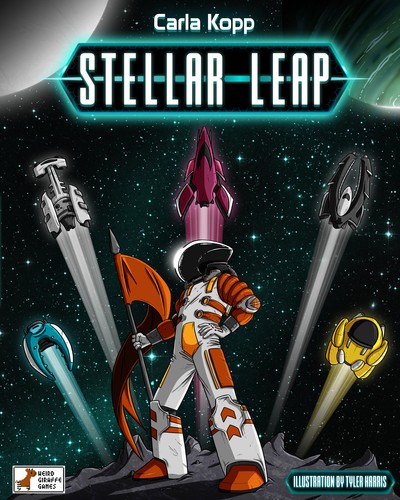Explore the galaxy, exploit the planets you discover for their resources and kick completing Aliens off your planets! What’s not to love?
Stellar Leap is at its core a 4x game. For those not in the know (including me-since I never knew I was playing them) that means: eXplore, eXpand, eXploit, and eXterminate. Lucky for me it is apparently on the lighter end of this type of game.
This is the second game from Weird Giraffe Games, their first being Super Hack Override, which I previously reviewed and backed without question. I have been fortunate enough to have had lots of exposure to Stellar Leap and seen many different iterations of the game, and I can already say I am going to be very happy with the end product. Let’s take a look:
Stellar Leap is a game where you will be collecting resources in order to be able to perform some actions. Other actions are free. The actions that you take will allow you to collect more or different resources on later turns.
Everyone will start out with a home Planet with a population of 1. After that, it’s up to you as to how your civilization expands out into the Universe.
You also will get a Player Board to track your actions and your current resources, an Individual Dice Power, and a Hidden Trait.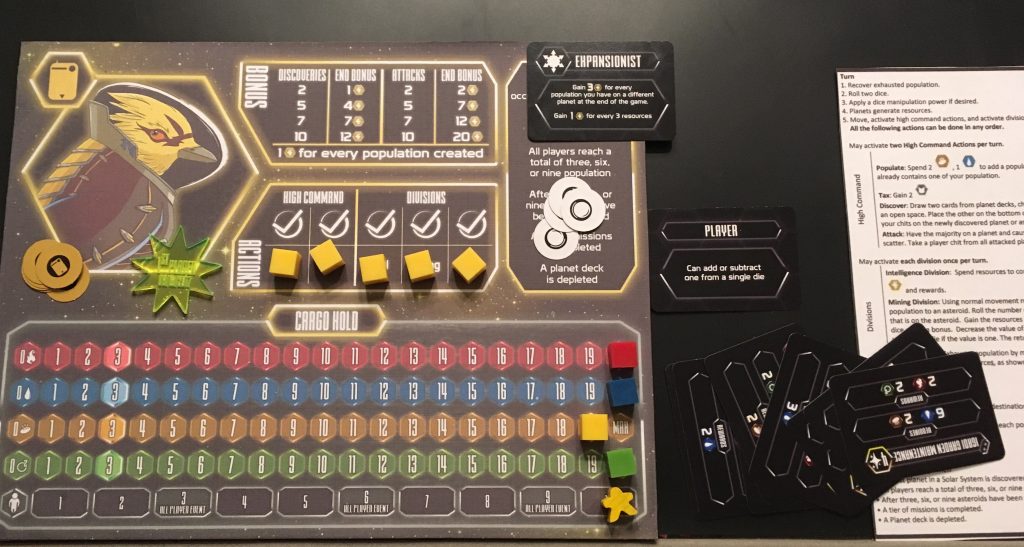
On their turn, the active player will roll 2 dice and have the option of using special (individual or group) Dice Powers to manipulate the Dice to show the result they desire.  If they don’t use any special powers, the face value of the dice, and their sum, indicate which columns will generate resources. (Example: If I roll a 4 and a 2, all planets in columns 2, 4 and 6 all generate resources). If you have an active explorer on any of these planets, you collect the resources that that Planet produces, whether it is your turn or not. This mechanic is very similar to the way resources are generated in Catan or money in Machi Koro.
If they don’t use any special powers, the face value of the dice, and their sum, indicate which columns will generate resources. (Example: If I roll a 4 and a 2, all planets in columns 2, 4 and 6 all generate resources). If you have an active explorer on any of these planets, you collect the resources that that Planet produces, whether it is your turn or not. This mechanic is very similar to the way resources are generated in Catan or money in Machi Koro.
Resources are key in the game since they are used to populate and travel to other planets, which will let you collect more resources on future turns. Resources are also used to complete Missions which will earn you Victory Points. You can also discover new planets and asteroids, all with their own resources to collect, which you can then send your explorers to.
So…the first thing you do is roll the Dice and everyone collects their resources. After that there are lots of things you can do on your turn. Here’s what you can do:
High Command Actions (2 per Turn – can do 1 twice if you want):
Populate – add another explorer to a planet you already have an explorer on. (This costs resources: 2 Food and 1 Water). Adding another explorer allows you to then expand to other Planets, setting yourself up for all the other actions, either on this turn or later ones.
Tax – Collect any 2 resources of your choice (this is probably the least used action, but sometimes the most useful).
Discover – Draw 2 planet cards and choose one to Discover. These cards can be from the Safe or Dangerous Planet Decks. Discovering planets will expand the known Universe, giving everyone more options. But…the player that discovers the Planet will place his marker on the Planet proving they discovered it and will count towards the Discoveries point total at the end of the game (Basically, plant your flag). Asteroids are also in the Planet decks.
Attack – Attack all others explorers on a Planet on which you currently have the majority Population (more than all other players combined). Exhausted explorers count toward the defense as well. Defeated explorers will scatter to another planet in the same solar system. Attacking other players never results in the removal of any of their explorers from the game, which makes it the nicest Attack ever. “Kindly leave this planet!”
Division Actions (You may activate all 3 Division Actions each turn, but only once for each different action):
Mining – If you can afford to fly one of your explorers to an Asteroid, you can Mine the Asteroid and collect the resource that the Asteroid is made of (usually a bunch of that resource). Each asteroid starts with 3 Dice on them to determine the resources you get from mining there. When you mine there, you roll 3 dice and add the highest value to the printed number of resources. Collect that many. The next time the Asteroid is mined (by anyone), they will roll 2 Dice, then 1, then you would just collect the amount of resources listed on the card. Asteroids are very awesome.
Labor – you can choose to Exhaust 1 of your explorers on any planet where you have a non-exhausted population. This will allow you to collect some of the resources that the Planet would normally generate. Usually you would Labor on a Planet where you have a population of more than 1, so that if that Planet generates resources on subsequent turns, you would still collect your share.
Intelligence – You can choose to spend some of your resources to complete Missions to earn Victory Points (VPs). 4 Missions are always available for everyone to see and complete. Once completed, the Missions are placed in your player area and count towards your VP total at the end of the game. They are now unavailable to anyone else, but another one is drawn and put in its place. As the game goes on the Missions get harder (cost more resources) and are worth more VPs.
On your turn, you can do any of these actions, High Command or Division, in any order.
In addition, each player has a secret Trait card that has an objective that you will be working on separately from everyone else. 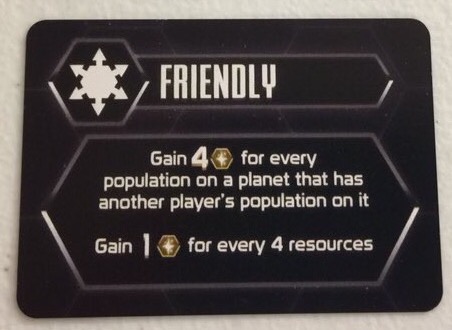 These hidden objectives are worth a certain amount of VP at the end of the game. These may be extra VP for every Mission completed, or for Discovering the most Planets or for having explorers on lots of different planets. These objectives greatly change the way you play the game each time, since you will be trying to do things differently than other players, and help you to have a different experience each time you play.
These hidden objectives are worth a certain amount of VP at the end of the game. These may be extra VP for every Mission completed, or for Discovering the most Planets or for having explorers on lots of different planets. These objectives greatly change the way you play the game each time, since you will be trying to do things differently than other players, and help you to have a different experience each time you play.
But wait, there’s more! Certain actions or results will also trigger random Events. Things such as discovering a certain number of Asteroids, all players reaching a certain population level, a Solar System being completely discovered will all trigger an Event. These Events can be good or bad for everyone, and multiple Events can trigger immediately one after another. Once 6 Events occur, the end of the game is triggered.
So, let’s look at an example of a turn:
Stella rolls the dice. She chooses to use the community power to manipulate the dice, instead of her player power, as it gives her the result she wants. After everyone who has active explorers on Activated Planets collects resources, she assesses what resources she has and decides to Mine a water Asteroid first, because her Water is running low. The Asteroid has a value of 2 left on its Die. She rolls two dice and gets a 7 adding that to the 3 listed on the Asteroid card and collects 10 water. She now has plenty of Water, and decides the next thing to do is Populate. Spending the 2 Food and 1 Water, She adds 1 Explorer to a Planet she already had 2 Explorers on, giving her more population than all other players combined, so she decides to Attack. She does this and scatters the other players’ Explorers to other Planets in the Solar System. She has already used her 2 High Command actions, so all she can do now is the Labor action and the Intelligence action. She needs 2 more Oxygen to be able to complete a Mission, so she has 1 of her Explorers Labor, earning the needed Oxygen and then Completes the Mission which will earn her VPs at the end of the game.
So…what do I think?
I really enjoy this game. In fact, the more I play it, the more I like it. It provides you with tons of choices every turn, and enough player interaction to keep you interested off turn. Everything builds on everything else.
The real decisions come into play when you are balancing the amount of resources that you currently have with the amount that you have to spend to get the results you want.
Resources drive the game. You need enough Fuel and Oxygen to travel to other Planets and Asteroids. You need to have enough Food and Water to increase your Population in order to spread your civilization among the different Planets, thus making it possible to collect the resources needed to continue doing everything else.
The Events add a spark to the game every so often that keeps it from getting monotonous. You can also intentionally trigger an Event or two on your turn if you are paying attention to where things currently stand in the game. If you feel you are doing really well after 5 Events, you can trigger the last 1 and end the game.
Attacking is not like attacking in most games. Being attacked by someone doesn’t completely mess up plans for your next turn. It does prevent you from collecting resources if your dice rolls come up, but since your explorers move to another planet in the solar system (if at all possible) Your plan will still be mostly in tact, since the cost for movement will still be the same.
Mining may be a little overpowered, but I’ve not played a game yet where I didn’t have a chance to mine at least 1 or 2 Asteroids during the game. So, everyone usually gets to benefit pretty equally, so I didn’t mind too much, and the designers have toned it down quite a bit so I’m okay with the Asteroids. In fact, I love it when they come into play.
So, what’s not to love?
The only thing I’ve found that troubles me is the learning curve for new players. When playing with inexperienced players, down time may be a bit much – as they will be constantly trying to figure out what their best moves are. The first time I played with 3 new players, it took 45 minutes for us to get through 3 rounds. You have a lot of options, which makes for really interesting gameplay, but can be a bit daunting if you are not used to this type of game. On my turn I’m trying to move my explorers around to be in position to collect resources, add more explorers, mine Asteroids, complete Missions and maybe even Attack other players. It can be a lot.
But, it is because there are so many options that there can be so many different paths to victory and you will always have something to do. Once you get the hang of all of your options, you start to plot out your moves when it is not your turn, and Player’s turns start moving much faster.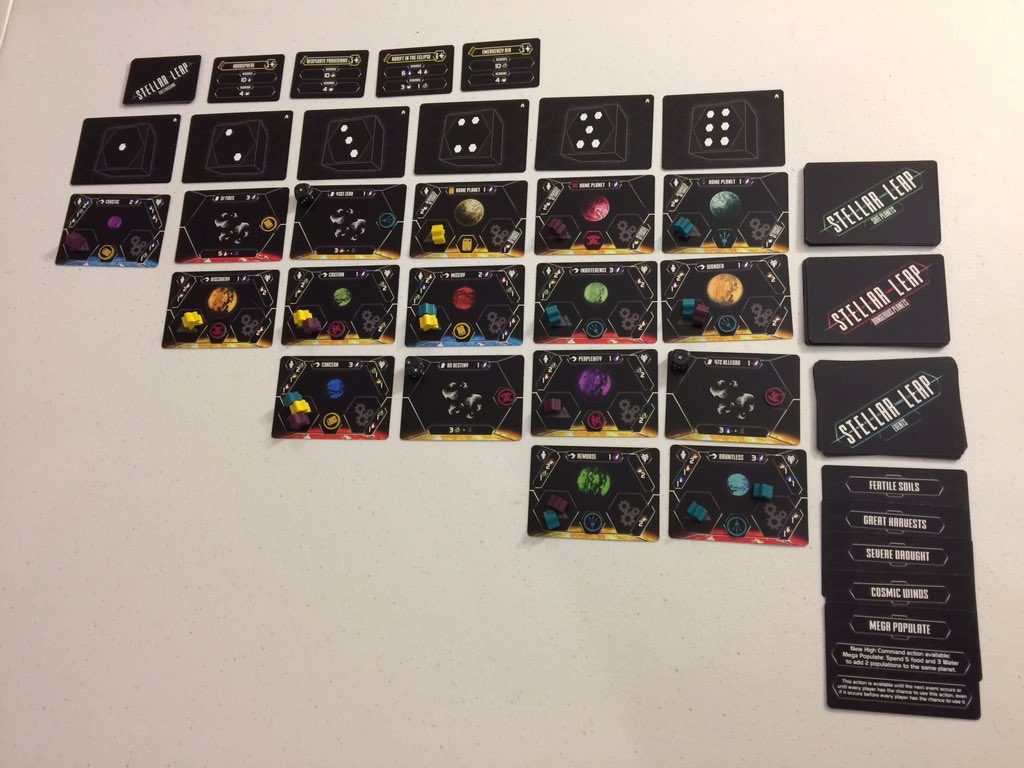
Overall?
Stellar Leap is a really solid game. The design provides real choices and the gameplay is very satisfying. The artwork is fantastic and very thematic. Everytime I play this game I get better at it, which makes me want to play again.
I will be backing this one immediately. Ninja approved!
Weird Giraffe Games loaned me a copy of the game to preview in exchange for an honest review. You should also know that the creators are friends of mine, and lucky for them I like this game a lot. It would’ve been awkward for everybody if I have hated it.
